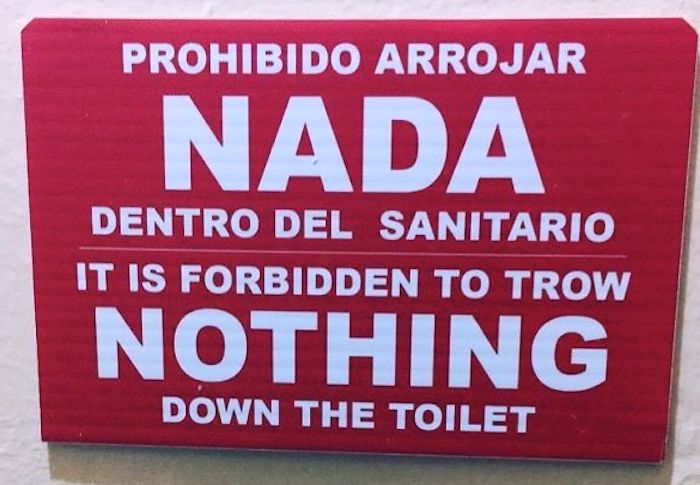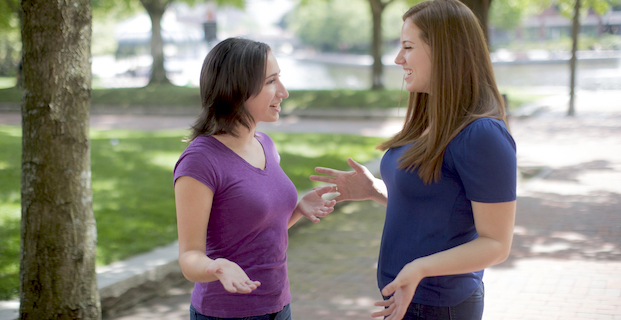by Mark Bloom | Sep 7, 2021 | Communication

Aren’t Words Serious?
The writers and editors at Ray Access take words — and writing — seriously. After all, clients pay for the words produced. But all work and no play make for pretty dull writing. When words collide is a playful way of saying that words can also entertain, sometimes on purpose and sometimes by accident.
As summer turns to autumn, let’s not forget that life can be fun when words collide. Whether it’s a poor translation or a purposeful slip of the tongue, words used incorrectly can put a smile on your face. Here are some examples, attributed when the author is known:
What Happens When Words Collide?
In a London department store: “Bargain Basement Upstairs.”
In an office: “Would the person who took the step ladder yesterday please bring it back … or further steps will be taken.”
In an office: “After tea break, staff should empty the teapot and stand upside down on the draining board.”
In a safari park: “Elephants please! Stay in your car.”
At a conference: “For anyone who has children and doesn’t know it, there is a day care on the 1st floor.”

At a newspaper office: “A gossip is someone with a great sense of rumor.”
At a library: “The man who does not read good books has no advantage over the man who can’t read them.” (Mark Twain)
On a country gate: “The farmer allows walkers to cross the field for free, but the bull charges.”
At a place of worship: “We are here on earth to do good unto others. What the others are here for, I have no idea.” (W.H. Auden)
At a math conference: “The generation of random numbers is too important to leave to chance.”
On a bumper: “My mother is a travel agent for guilt trips.”
In an employment office: “Tell your boss what you really think about him and the truth shall set you free.”
At a comedy club: “He who laughs, lasts.” (Wilfred Peterson)
On a T-shirt: “Whenever I feel blue, I start breathing again.”
At the City Clerk’s office: “Love may be blind, but marriage is a real eye-opener.”
At a factory: “The man who fell into an upholstery machine is fully recovered.”
On a car being pulled by an RV: “I go where I’m towed.”
In an optometrist’s office: “If you don’t see what you’re looking for, you’re in the right place.”
In a psychiatrist’s office: “The only normal people are the ones you don’t know very well.” (Alfred Adler)
From a business coach: “A pessimist complains about the noise when opportunity knocks.”
On a leaflet: “If you can’t read, this leaflet will tell you how to get lessons.”
At Ray Access: “Quoting one is plagiarism; quoting many is research.”

The writers and editors at Ray Access hope you’ve enjoyed this brief detour from the business of writing. While we take words seriously for our clients, when words collide, the outcome can be unintentionally comical. When you need your words to be perfectly clear and on target, contact us.
Ray Access is a content marketing firm that delivers targeted words to empower your business. Contact us about your specific project to receive a quote or discuss your needs. We write website copy, blog posts, e-newsletters and more. Everything we do is thoroughly researched, professionally edited and guaranteed original.
by Mark Bloom | Dec 15, 2020 | Communication
Is There a Better Way to Use Zoom Video Conferencing Software?

As the pandemic drags on, more employees are beginning to feel the effects of Zoom burn-out. To avoid that and make better use of your time and video meetings, you need to find the best tips for using Zoom. Then you can minimize your meeting time and maximize the video conferencing software that’s gained so much popularity and notoriety in the past few months.
These tips for using Zoom may not all apply to your situation, but everyone who uses Zoom in any capacity will be able to gain some benefit by reading through this list of tips. Note that many of these suggestions are meant for those with paid Zoom accounts, not those who use the service for free.
Great Tips for Using Zoom
You’ve attended or held Zoom meetings. You may even recognize the pitfalls of the technology, from attendees who seem distracted to hosts who drone on and on. To get the best use out of the experience, follow these tips:
- Schedule your recurring meetings. Zoom meetings aren’t always one-off events. If you hold a regular meeting through Zoom, you can schedule them all on a recurring schedule. The advantage of this feature is that you can use the same link for the meeting every time you hold it. You may still send out invitations, but the link is always the same.
- Invite your attendees to get to know Zoom. You don’t want your attendees to be playing with backgrounds or accidentally mute themselves when speaking. If they’re new to Zoom, make sure they’ve already set up their default options and are already familiar with the software.
- Have a list of talking points before you start. Don’t go into any meeting unprepared, but especially not a virtual meeting. To avoid burn-out for all your attendees, make sure you stay on target. You can accept questions and comments during your presentation, if that’s important to you, but keep the meeting moving forward.
- Adjust your own video before you start. No matter what kind of device you’re using to connect to the meeting, make sure you come across visibly and in complimentary lighting. Make all your adjustments before joining the meeting to look as professional as possible.
- Test your audio before joining the meeting. Make sure you’re audible, but not screaming at your attendees. If you’re using a built-in microphone, test the clarity and volume before you join your meeting.
- Pick a neutral background. Be careful of using the Virtual Backgrounds that come with Zoom. While they may look cool, they take a lot of computer power and may cause parts of you to fade in and out if you tend to move around a lot. It’s better to find a place in your home or office that can make a neutral backdrop for your video meeting.
- Silence all the other notifications on your devices. Don’t let everyone else know that “You’ve got mail” or that your Amazon package has just arrived. Keep it professional.
- Mute all attendees when they arrive. Keep chatter to a minimum. You don’t want your group to be talking over you with each other. They’re in the meeting to get what you have to give. Of course, this is a meeting, not a video. When it’s appropriate, open it up for questions or allow feedback at times. And mute yourself when you’re not speaking.
- Share your screen when appropriate. You don’t need a slideshow presentation for a Zoom meeting. Sometimes, you just want to show the interface to your software or a cool website. Get creative.
- Remember you’re in a meeting. Behave just like you would in a face-to-face meeting. Dress appropriately, at least from the waist up. Be respectful of others. Remain professional at all times because people are watching you, even if it’s not your turn to talk. Don’t multi-task.
Remember these 10 tips for using Zoom, and you’ll have shorter, more productive meetings. You’ll feel better about them, and your attendees will thank you. That means they’ll come back for your next virtual meeting.
Ray Access is a content marketing firm that delivers targeted words to empower your business. Contact us about your specific project to receive a quote or discuss your needs. We write website copy, blog posts, e-newsletters and more. Everything we do is thoroughly researched, professionally edited and guaranteed original.

by Mark Bloom | Jun 1, 2020 | Communication

Be Aware of All the Dangers of Staying Home
People in lockdown used to think that the only mental health dangers posed by their situation was the lack of stimulation. You’re stuck in your home with your family, unable to go outside for longer than a trip to the grocery store or a walk around the block. When you get tired of streaming movies or binge-watching new series, your options become limited and you develop the condition called going stir crazy.
Everyone’s seen the signs: a lack of personal hygiene, a manic look in the eye, five-day-old clothes and a couch-potato lethargy. You learn to stay away to avoid an expletive-laced tirade or a request for a second breakfast. But it turns out there are more dangers to a quarantine than going stir crazy. In fact, Zoom fatigue is affecting more people all the time.
What Is Zoom Fatigue?
When you meet someone in person, you focus on them. You look at body language, listen for verbal cues and react accordingly. All business people are accustomed to communicating in person or over the phone. Once the conversation moves to a screen, hidden perils await.
For example, the video chat window in Zoom and other video communication programs show a small window of what you look like in your video to the others on the call. It’s meant to be beneficial, allowing you to adjust the height of your video feed, center the image if necessary, and fix the lighting so you look as good as possible. So far, so good, right?
The Symptoms of Zoom Fatigue
When you meet someone in person, you don’t usually think about how you look, at least once you enter the meeting. But when you see yourself on the screen during a video meeting, it’s a different story. Many people on Zoom calls obsess about the image of themselves. As a result, they:
- Notice themselves more: not just how they look, but how they may appear to others
- Force a smile during the length of the call
- Plan or change the backdrop of their presentation on-screen to create a pleasing effect
- Exaggerate their expressions and responses
These actions may not seem like much, but amplified over multiple video chats in a day, and it leads to fatigue. The characteristics of Zoom fatigue include a sense of overall exertion, stained eyes, a throbbing headache and even dizziness. These symptoms stem from the extra concentration it takes to be online, looking at yourself and others for the full duration of the meeting.
How to Avoid Zoom Fatigue
Even before the coronavirus pandemic and stay-at-home orders, people tracked the time they spent in front of a screen, whether it was the TV, a computer, a smart phone or a tablet. Too much screen time was thought to be unhealthy. It is, especially when you see yourself in the screen the whole time. So the best way to avoid Zoom fatigue is to limit your screen time. Get offline and go for a walk. Do some yoga or other form of exercise.
Other ways to limit your exposure and risk of video chat fatigue include:
- Ask the people you meet with to turn off the cameras and have an occasional audio-only call
- Focus on others, not yourself, during a video meeting
- Don’t look at the screen during your meeting
- Force yourself to take notes, which diverts your attention
- Keep Zoom meetings brief
Ray Access is a content marketing firm that delivers targeted words to empower your business. Contact us about your specific project to receive a quote or discuss your needs. We write website copy, blog posts, e-newsletters and more. Everything we do is thoroughly researched, professionally edited and guaranteed original.
by Elle Ray | Feb 24, 2020 | Communication
The Pros and Cons of the Compliment Sandwich
The compliment sandwich is a tool you can use to soften the blow of criticism. People, including your peers and employees, often cringe at criticism (unlike professional writers, who relish feedback). But when you learn to use this sandwich technique properly and in the right situations, you’ll discover it’s an effective way to get your negative remarks across while you:
- Leave the other person’s feelings intact
- Keep their ego unbruised
- Avoid acquiring a reputation as a jerk
- Appear encouraging rather than disparaging
However, there’s always the risk that your compliment sandwich falls flat, especially when it’s insincere. Don’t use it to hide your criticism in a veiled attempt at savings someone’s feelings. Above all, be honest, or your attempt may cause the opposite of your intended effect — and make you out to be an even bigger jerk.
A Good Sandwich
A tasty sandwich is made with two pieces of good quality bread or inside a soft, mouth-watering bun. It’s typically filled with hearty items like cheese, soy protein or meat — and piles of condiments and complementary vegetables. Think of a juicy steak burger on a delectable, fresh-baked artisan bun with lettuce, tomato, onion, mustard and relish.

A proper compliment sandwich is composed of a meaningful compliment on the bottom, followed by a substantial and practical critique or flavorful advice, topped off by concise, worthwhile praise. And while the bun should be warm and appetizing, it needs to be strong enough to hold the sometimes slippery ingredients that sit in between. Maintain the integrity of the compliment sandwich by ensuring all the ingredients are related and go together well.
A Bad Sandwich
Not too many diners appreciate peanut butter and jelly on a burger. Likewise, few believe that a harsh criticism lodged between two superfluous, unrelated compliments is very palatable either. A poorly delivered compliment sandwich leaves the recipient more confused than motivated. Too often, it feels like the proverbial back-handed compliment — which is just as dangerous when delivering negative feedback. A bad sandwich leaves you with someone who’s not very receptive to your feedback.
When you’re served a bad sandwich in a restaurant, you’re usually going to do one of three things:
- Send it back
- Leave it on the plate untouched
- Throw it out
The same is true of taking a bite out of a compliment sandwich — if you take a bite at all. You may go on the offensive and send back the offensive remarks, totally ignore the entire statement or toss it in a pile of useless information that eventually ends up in the trash.
Sandwich Delivery
It behooves you to think about the contents of your compliment sandwich before you deliver it. For example, a staffer creates a new website that has some striking flaws that need to be fixed before you can present it to the client. You can be direct and brutally honest (as some management gurus suggest) and say to your developer:
“I can’t give this mess to the client, fix the content and the layout and get it back to me by the end of the day.”
You can try a slapped together compliment sandwich:
“Your work area is so clean today. This website sucks. But you’ve really been doing well to get to work on time lately.”
Or you can give it a little thought. Look for what the website developer did right first and think about qualities she has that you admire. With the bun in hand, you might say:
“The graphics on this site are amazing. I especially like the charts you inserted. But the rest of the content falls flat and doesn’t say what we need the reader to hear. It kind of jumps around too, making it hard to follow. I know you can fix this in no time because you want to make sure the client is really satisfied. I look forward to your revisions.”
The Final Review
The developer may not like what she hears. After all, she thought she had nailed it and was done. But she’s not completely defeated and feels like she got some praise for her hard work. And if she really does care about her work — and about pleasing you and the client, she’ll give it her best to make the corrections you pointed out.
Used wisely, the compliment sandwich serves its purpose. The person to whom you’re providing the feedback hears what you’ve said and takes it in context. You’ve framed your criticism with compliments and provided specific feedback for the person to add a little polish and shine it up. You’re considered thoughtful and kind, while maintaining your high quality expectations. Forgive the cliche, but that’s a win-win.
Ray Access is a content marketing firm that delivers targeted words to empower your business to succeed. Contact us about your specific project to receive a quote. We write website copy, blog posts, e-newsletters, and more. Everything we do is thoroughly researched, professionally edited and guaranteed original.
by Mark Bloom | Feb 18, 2020 | Communication
Use Every Tool Available to Say What You Mean

If you’ve been reading our blog posts, you already appreciate the value of clear communication. You already know how to give an effective compliment. And you already understand the power of body language.
When you have something to say — whether it’s an energizing presentation to your team or a big sales pitch to a new client — how you say it matters as much as what you say. Your actual words may go in one ear and out the other, but your attitude and demeanor leave a lasting impression. How you say it involves your:
- Body language
- Hand gestures
- Facial expressions
- Tone of voice
- Eye contact
- Environmental circumstances
How You Say It with Body Language
We’re writers. Words matter to us on many levels. So when we tell you that your spoken words to a group or even one-on-one convey very little, you have to believe it. We’d prefer it to be false, but it’s been proven again and again, and we can’t ignore it. Your body language when speaking says much more than the words you utter.
The number, in fact, is seven percent. What you say contributes only seven percent of your message. How you say it with your body language and other unspoken cues provide the other 93 percent. Be conscious of your body when you speak. Use it to convey and reinforce your message. When people listen to you, they’re watching your body language. A confident posture lends weight to your words.
How You Say It with Hand Gestures
Some people tend to talk with their hands. Their extended pinky and thumb become a telephone receiver. A pointed index finger and thumb become a pistol. Sometimes, a conversation consumes their full reach. But gestures add emphasis to your words, just as a conductor punctuates the music with his gesticulations.
Your audience wants to know that they can trust you. Yet no one trusts a speaker whose arms hang limply. Your hand gestures can win an audience over. Watch any great speaker; every one of them use their hands to sweep meaning into their words. So help your listeners understand the full extent of your message by incorporating hand gestures into how you say it.
How You Say It with Facial Expressions
Like body language and hand gestures, your facial expressions communicate lots of information on their own. Think of the very different messages you express when you say, “I love to write blog posts” — once while smiling broadly and once when scowling. The same words take on opposite meanings. No matter what you say, people are watching your face for clues to your attitude. Use your expression in conjunction with your words. Put the whole package together to make your point stronger.
You can convey your mood, your emotions and your attitude with just a look. Even if your audience doesn’t consciously process your expression, it sticks in their minds. They can’t help but understand it. That’s just part of human nature. You’d do yourself a disservice if you didn’t use your facial expressions to guide your listeners toward a deeper understanding.
How You Say It with the Tone of Your Voice
Communication is a multi-sensory experience. When people listen, their ears naturally open. Their eyes observe. Their noses are actually on alert for pleasurable or foul smells. The brain puts the input together into a package that helps the brain not only accept the information provided, but also to decide whether to trust the speaker.
How you say something — how you use the inflection, pitch and tone of your voice — engages your audience directly. It’s so important in the art of storytelling that it’s become part of how we communicate. You can express tension, surprise or gravity through the tone of your voice. When you use it to reinforce your message, your message has a more lasting impact. Use your voice to connect with your listeners.
How You Say It with Eye Contact
To connect with someone, you have to look them in the eye. That look conveys trust and honesty. While it’s easy to do when you’re talking one-on-one with someone, it’s a feat when you’re speaking to a group. But spread the love around the room. Maintain eye contact with individuals for several seconds before moving on. That connection opens the brain to be more receptive.
Eye contact is a necessary part of building trust with people. But you have to create a delicate balance. If you don’t maintain eye contact long enough, you lose any good will you intended. Look too long at one person, however, and it becomes a weird power play between you and the audience member. Make your presence real by connecting with your audience through eye contact.
How Environmental Circumstances Impact What You Say
It’s not so much what you say as to what your audience hears. If you’re holding court in the midst of a crowded subway station, few are going to pay you any attention. If you’re speaking to your crack management team in a pristine conference room, on the other hand, you can be sure that everyone is hanging on every word.
By providing an environment that’s conducive to the meaning of your message, you encourage your audience to better absorb that message. A comforting environment puts all the focus on your speech, as there are no distractions. And then, if you’re using all your nonverbal clues, you can reach your audience more effectively. And that’s the key to communication.
Ray Access is a content marketing firm that delivers targeted words to empower your business to succeed. Contact us about your specific project to receive a quote. We write website copy, blog posts, e-newsletters, and more. Everything we do is thoroughly researched, professionally edited and guaranteed original.
by Elle Ray | Feb 10, 2020 | Communication
Are Your Compliments Backfiring on You?
Everyone loves getting compliments. And they can be very useful as you try to win friends and influence people. So while you try to insert compliments into your repertoire, be careful how you throw them around; don’t abuse the power of the compliment. For when the people around you get used to the two poles of “suck up” or “put down,” that power can turn against you.

A sincere compliment does its job and does it well. In fact, the power of the compliment, when given in the spirit of true admiration, is immeasurable. A well-placed real compliment:
- Shows a level of respect that’s hard to dispute
- Acknowledges the receiver as someone of significance
- Leaves the other person with a lasting impression that they can draw upon on dark days
- Affords you a true sense of humility
- Builds trust
- Puts everyone, including you, in a positive frame of mind
Beware False Starts
You’ve most likely heard that communication is largely made up of body language and tone of voice — to the tune of about 85 percent! Most people aren’t tone deaf to insincerity and dishonesty. The power of a compliment given in haste, with little thought to the truth, carries equal amounts of distrust, negativity and disrespect.
Instead of feeling grateful for your attention, the receiver of a backhanded compliment or one that obviously is not sincere just leaves the person feeling annoyed and even resentful. Instead of garnering goodwill, as you’d hoped the power of the compliment would deliver, you end up being the boy (or girl) who cried wolf. In other words, the next time you offer your appreciation, it’s going to be received with an air of doubt by those who received that previous misguided compliment.
Consider the Source
Make sure you’re using the power of the compliment for good and not to put someone in their place or make yourself look superior. So consider your motivation for extending the approval. You could ask yourself the three questions that circulate as social media memes on a regular basis:
- Is it true?
- Is it kind?
- Is it useful?
If you answer “yes” to all three, then use the power of the compliment with a deft touch and beware of falling into one of categories below before finally letting it rip:
- Patronizing. The definition of “to patronize” is to be helpful, and when you adopt this form of compliment, you may have answered yes to all the ethical questions and truly have your heart in the right place. It’s usually the delivery that falls short for some reason. Since you know the power of the compliment, you may believe that it actually may help someone feel better about themselves. At the same time, however, you feel slightly better than that person and at least a little superior. And it shows in your tone as you talk down to him or her. A patronizing compliment may actually be a sibling of the South’s well-known put-down of “Bless your heart.”
- Too Frequent. For many people, once they discover the power of the compliment, they wear the heck out of it. And subsequently it wears out its usefulness. Too many compliments delivered too often actually begin to have the opposite effect. Think about when you truly enjoyed a fine, expensive piece of chocolate on Valentine’s Day and because it was so good, decided to eat 10 pieces every day. It soon loses its specialness and may even make you sick.
- Not Quite Appropriate. Sometimes, you may have to struggle to find something nice to say to certain people. But you still want to exact the results that come from a well-placed compliment. You know it needs to be sincere, but you don’t know exactly what to say. Be very careful about complimenting people about certain subjects unless you know them intimately — like the fit of their clothes, their weight, their latest facelift, their choice in partners or any other intimate topic that could land you in HR with a harassment charge. Shoot instead for safe topics such as work-related efforts on the job, their handling of a difficult situation or their cooking.
- Unclear and Questionable. The last thing you want is to waste the power of the compliment on an ambiguous statement that allows you to feel great about yourself, but leaves the other person scratching her head. For example: “I finally get to read well-written copy,” may in fact be heard as “You’ve been delivering crap all this time.” If the endorsement may be taken as an insult in disguise, rephrase it so it’s clear and unmistakably positive with something like: “After reading everyone else’s poor submissions, it’s refreshing to read your great copy.”
- From the Heart. While the power of the compliment offers great benefit to the giver, when it’s delivered with no ulterior motive, you can usually be sure it’s from the heart. Rarely is the sentiment taken wrong when it’s clear you have nothing to gain by giving it. In fact, you may not even feel the same flood of endorphins that the receiver of your praise gets from a sincere compliment. But know that you are building a well of goodwill and respect from those on the receiving end of your honest acknowledgements.
Ray Access is a content marketing firm that delivers targeted words to empower your business to succeed. Contact us about your specific project to receive a quote. We write website copy, blog posts, e-newsletters, and more. Everything we do is thoroughly researched, professionally edited and guaranteed original.









